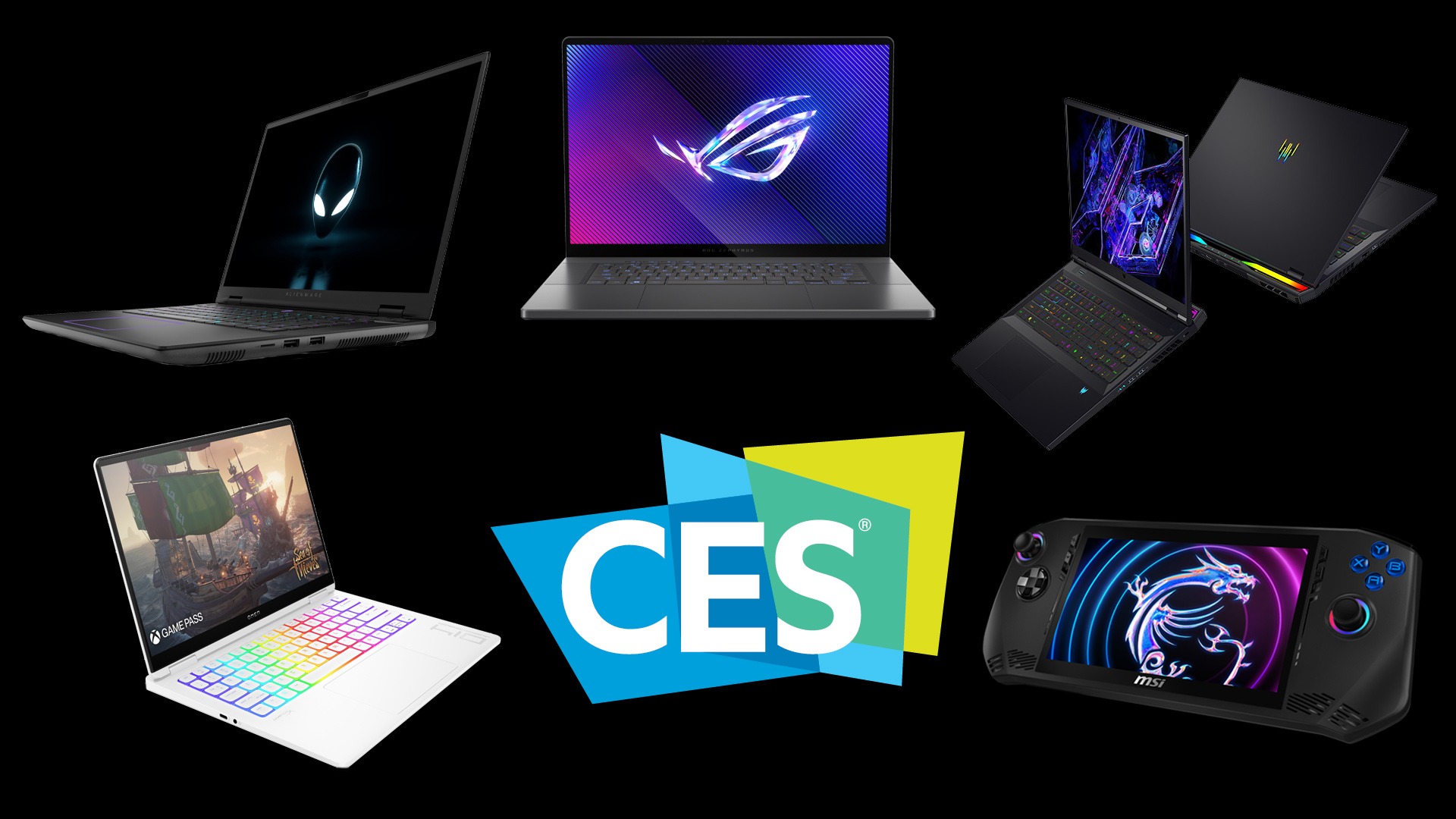Components to watch
New chips, cards, and PC parts for the new year! CES 2024 saw a burst of innovation from well-known companies such as AMD and Nvidia, as well as some lesser-known ones. Here are some of the most impressive DIY creations.
Since its inception, CES has been about computers. And, 57 exhibitions later, its pounding heart has endured wave after wave of consumer electronics fads, including the recent push for electric automobiles at the yearly event. This year’s CES didn’t disappoint, with remarkable cooling solutions, ultra-compact gaming desktops, and supercharged graphics cards.
If you’re interested in which desktop and component goods topped everything we saw during the conference, check out the comprehensive Best of CES 2024 piece. Continue reading for a more in-depth look at the coolest desktop PC items and DIY hardware we saw firsthand.
- Best Gaming Desktop: Asus ROG NUC

The return of the NUC tiny PC series under the Asus ROG gaming brand is a good development. The Asus ROG NUC is the top compact gaming desktop of the show, putting a lot of gaming power into a 2.5-liter package. The small PC is powered by Intel “Meteor Lake” CPUs (the Core Ultra 7 155H or Core Ultra 9 185H), as well as Nvidia GeForce RTX 4060 and RTX 4070 mobile graphics cards. Weighing less than two pounds, it can be used as a console replacement or a living-room PC with AAA game capability. The tiny chassis accommodates up to 32GB of RAM, expandable storage, and a variety of connectors. Given that the ROG NUC’s components and performance are close to those of gaming laptops, we expect the price to be comparable when it launches this spring.
- Best Productivity Desktop – ASRock DeskMeet X600

The Ryzen-based DeskMeet appears to be an inconspicuous black cube from the outside, which is why we’ve included a few shots of it without its shell. This small PC has a distinctive internal design that enables a great deal of upgrade or configuration flexibility, as well as some cutting-edge specifications. You can mount 2.5-inch and 3.5-inch disks on one of two brackets, as well as a variety of M.2 drives (including one PCI Express 5.0 drive!) on the top and bottom of the pre-installed motherboard. The board supports the latest AMD AM5 processors, so you may install one and use its integrated graphics, though small graphics cards will also fit.
The chassis is just large enough for ATX power supply, but the back-panel plating can also accommodate smaller SFX units. Furthermore, the PSU’s screw-mount design allows for easy removal and access to the case’s internals for repair or upgrades. ASRock showed it off with a snub-nosed Radeon RX 7600 XT. The most startling feature is that the PC supports high-speed USB4 via a socket on the front panel that connects directly to the bespoke motherboard.
- Best Graphics Card- MSI GeForce RTX 4080 Super 16G Expert

Nvidia’s latest GeForce RTX 40-series Super graphics cards are truly game-changing. Among all of the card versions we saw at CES, the MSI GeForce RTX 4080 Super 16G Expert stood out the most. Built like an even more premium version of Nvidia’s Founders Edition cards (with a blower fan on either side), this new MSI card features noticeable metal portions and beautiful diagonal metal vents that give it the appearance and feel of a luxury sports car in the GPU world. In addition to having more cores than the ordinary RTX 4080, the RTX 4080 Super boasts faster GDDR6X memory and is less expensive, albeit this top-tier variant is expected to cost more.
- Best Processor: AMD Ryzen 7 8700G

AMD’s Ryzen 7 8700G is intended to combine entry-level gaming performance with a powerful CPU in a single, handy, and cost-effective device. In its press statement, AMD compared the Ryzen 7 8700G to an entry-level graphics card, the Nvidia GeForce GTX 1650, and an Intel Core i5-13400F, claiming that the Ryzen 7 8700G without a graphics card will frequently deliver a better gaming experience. We need to verify the truth of this allegation, but it appears reasonable and exciting if true: It will reduce the cost of assembling an entry-level gaming PC to levels not seen in years, with the Ryzen 7 8700G costing only $329.
- Best Showcase PC Case – ThermalTake The Tower 300

We’ve examined various Thermaltake The Tower series PC cases over the years, both large and small, but we think the 300 is our favorite. This Mini-ITX case is tall and can accommodate up to a 420mm radiator on the right side. The front glass panel is a three-piece prism shape with snap connectors, and the side panels attach and detach using neodymium magnets. An optional front-face LCD kit complements the case bottom, and a horizontal stand, when combined with a replacement base, allows you to put the case horizontally on your desk with the glass interior pointed up at you. Best of all, however, are the color options: yellow (“Bumblebee”), Matcha Green, and Thermaltake’s new distinctive Hydrangea Blue, which commemorates the company’s 25th anniversary.
- Best Motherboard: ASRock Phantom Gaming B760I Lightning WiFi

What’s unique about a B760-chipset Mini-ITX motherboard? What about one that supports the most powerful and fast-running Intel desktop processors? A beefed-up VRM cooling configuration, a 14+1+1 phase design, and a reduction in the depth of the I/O ports to accommodate more robust power circuitry: all of this makes the B760I Lightning one of the few compact Intel LGA 1700 motherboards suitable for use with high-end chips like the Core i9-14900K. Furthermore, this board boasts several other capabilities, including built-in Wi-Fi.
- Best Power Product – Enermax PlatiGemini 1200W

Enermax is well-known for providing long warranties and using only Japanese capacitors. However, this power supply’s potential claim to fame is rather different: With Intel’s ATX12VO initiative in the air for the past few years, this 1,200-watt power supply straddles the line between the present and a hypothetical ATX12VO future, while also supporting the forthcoming ATX 3.1 standard and 80 Plus Platinum certification. This high-end PSU supports both the upcoming ATX12VO 10-pin connector and the full 24-pin power connector found on the vast majority of contemporary motherboards. If you want some insurance while using today’s standards instead of tomorrow’s possible ones, in a power supply that you’re likely to keep through your next PC and possibly the one after that, the PlatiGemini is an appealing alternative.
- Best Cooling Product: XPG Hybrid Cooler

This two-fan cooler can accommodate CPUs with a TDP of up to 280W. The difference here, however, is that it falls somewhere between an AIO liquid cooler and a pure air type. The “radiator” is sandwiched between two 120mm fans, with internal liquid circulating through the cooler’s body and the top module, which is serviced by a small impeller-type mechanism inside.
XPG claims it should support all recent platforms, including powerful HEDTs such as Intel Xeon and AMD Ryzen Threadripper Pro. It is intended to compete with high-end, large, “pure” air coolers from companies such as Noctua.
- Best New DIY Ecosystem: Cooler Master Mythril Open-Loop Series.

Mythril is Cooler Master’s a la carte liquid-cooling component ecosystem, designed to make it simple to create unique loop projects using a range of connections, elbows, and distribution plates. The possibility to employ square acrylic tubing, as opposed to the traditional round hoses or tubes, adds to its uniqueness.
Specially engineered fittings make it easy to join and disconnect these square tubes (you can’t screw in a square, of course!), and Cooler Master will provide a unique tool for angle-bending square tubing. The portfolio will also feature several colored coolants.
- Best Sustainable PC DIY Product – In Win POC One

Consider the cardboard, container volume, and fuel required to transport what is effectively an empty box (i.e., a PC case) across oceans. Win has a clever solution for eliminating all of this: a foldable PC case. Last year, the business demonstrated its original proof-of-concept case, which came in the shape of a pizza box and was made of bendable metal sheets that could be folded into a lightweight Mini-ITX chassis.
Consider the updated POC One (presented as a prototype at Computex 2023 and now in production) to be a higher-end version of the first model. With an all-aluminum design and rubber silicone hinges, In Win can transport this Mini-ITX case flat. It is simple to fold it into form and connect the accompanying pop-down acrylic panel to the front face. The POC One will most likely cost around $200 and will be available in black or silver.

























